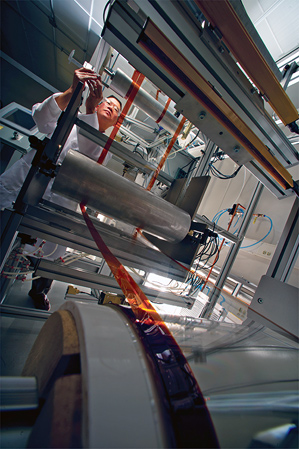Glass That Bends the Rules of Manufacturing
In 2011, a Corning researcher named Terry Ott faced a problem that nobody else had needed to solve in the company’s 160-year history: how to make sheets of glass that could be rolled onto spools.

The challenge arose because Corning had developed a new kind of glass, known as Willow, which is as thin as a sheet of paper and acts a bit like it, too—if you shake it, it will rattle, and it can bend enough to be spooled. It could be the basis for displays in thinner, lighter cell phones and tablets—or for entirely new products, like displays that fit the curve of your wrist.
Inventing the glass was an achievement in itself for Corning, which also makes the durable Gorilla Glass used in Apple’s iPhone and other mobile devices. But Willow, which is one-third as thick as Gorilla Glass, would be a meaningless breakthrough if Corning couldn’t figure out how to make it in large quantities—and in a way that customers could use on their own production lines. The way Corning solved the problem of mass-producing Willow helps illustrate the extent to which technological innovation depends on close connections between R&D and manufacturing.
Ott had been on the team that created Willow in Corning’s Sullivan Park research facility in Corning, New York. In September 2011 he moved to Corning’s display factory in Harrodsburg, Kentucky, to find a way to produce the glass at commercial scale. This was no easy feat. Corning’s factories typically churn out individual panes of glass that are cut into the sizes needed for displays. Ott would have to devise manufacturing lines that would produce Willow glass in strips as long as three football fields. This method is more cost-effective than producing individual panes because each cut inevitably wastes glass, but it’s possible only if the glass is thin and flexible enough to roll onto spools.
Some of the work was straightforward: Willow is made with Corning’s core manufacturing technology, a process called fusion forming, which involves heating glass in a trough. At the right temperature, the molten glass will evenly pour over the sides and then solidify at the bottom, where it can be drawn downward into a vertical sheet and then cut.
But to get Willow made in continuous sheets, Ott’s team had to figure out the proper rate at which to draw the glass out after it fused, so that the surface quality would be consistent. The process of getting the glass onto rollers also required new equipment. And Ott’s team had to develop thin plastic tabs to line the edges of the glass and keep it from touching anything on the rollers, which could create defects in its surface. The tabs are applied to Willow’s edges as the glass is being drawn.
Now Corning has to help its customers figure out how to bring Willow into their manufacturing lines. Although a continuous roll-to-roll process is the most efficient way to use a spooled product like Willow, display factories don’t use roll-to-roll equipment; they work with discrete pieces of glass. So Dipak Chowdhury, a Corning vice president, has been working with some of Corning’s partners to help them develop equipment and processes that will feed the spooled glass into existing manufacturing lines. Eventually, if Willow proves a commercial success, customers may develop new facilities based on roll-to-roll manufacturing.
Chowdhury says the first devices that use Willow glass will appear in 2013. Already, however, Ott can claim a success in having figured out how to make it. Some glass broke while he and his team tested the production of Willow, but “broken-glass moments happen on every line,” he says. “We sweep it up and we try again.”
Keep Reading
Most Popular
Large language models can do jaw-dropping things. But nobody knows exactly why.
And that's a problem. Figuring it out is one of the biggest scientific puzzles of our time and a crucial step towards controlling more powerful future models.
The problem with plug-in hybrids? Their drivers.
Plug-in hybrids are often sold as a transition to EVs, but new data from Europe shows we’re still underestimating the emissions they produce.
Google DeepMind’s new generative model makes Super Mario–like games from scratch
Genie learns how to control games by watching hours and hours of video. It could help train next-gen robots too.
How scientists traced a mysterious covid case back to six toilets
When wastewater surveillance turns into a hunt for a single infected individual, the ethics get tricky.
Stay connected
Get the latest updates from
MIT Technology Review
Discover special offers, top stories, upcoming events, and more.